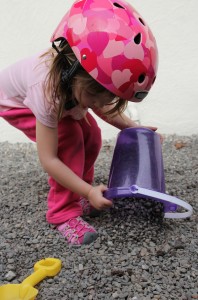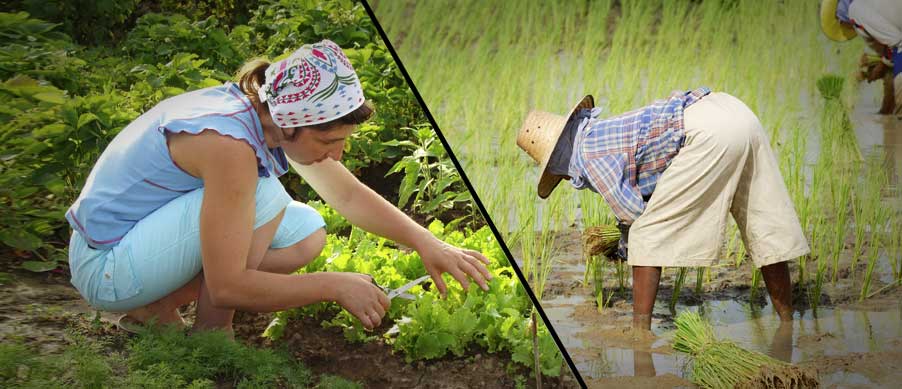Posture Tips: Bending
Look at the dramatic difference in the bending posture between cultures. The American woman is rounding her spine, slumping her shoulders, and pushing her head forward. Unfortunately, this is very common in the industrialized world. We often hold the pelvis in a tucked position, preventing the hips from bending to their full potential. Instead we bend at the mid-back or waist, compressing the spine.
I would be willing to bet that all 3 people in the photos below have back pain, especially in the area just below their shoulder blades. Notice how each of them are holding the tailbone in a downward position and creating a hump in the middle of the back. They each have their legs very close together, which can discourage a full release of the pelvis.



All three of these people are bending from the back instead of the hips.
By contrast, the photos below show people hinging from the hip and keeping the spine long. They are completely releasing the hips and allowing the tailbone and sitz bones to point backwards. There is a quality of lengthening from the pelvis all the way up through the crown of the head. Young children naturally bend from the hip, but start to bend from the spine around age 4. In some rural, non-industrialized countries it is still common to see hip hinging, but it is very rare in the first world.



All three photos show people bending from the hips with a straight back.
 Bending with a straight spine is the “ready” position for many athletes because it facilitates easy movement in any direction. It is a balanced position, meaning that if we created a statue of someone holding that stance it would not fall over. Balanced positions usually require less muscle strength to maintain.
Bending with a straight spine is the “ready” position for many athletes because it facilitates easy movement in any direction. It is a balanced position, meaning that if we created a statue of someone holding that stance it would not fall over. Balanced positions usually require less muscle strength to maintain.
 Unhealthy spinal bending requires the abdominal muscles to engage, creating unnecessary tension in the body. With the spine long the optimal athletic performance becomes possible. Even though the athletes photographed here are alert and ready for physical activity, they also have a quality of openness that is not present in the examples of poor posture. The muscle tension in the athletes is facilitating their activity, while the muscle tension in the rounded spine examples is actually inhibiting their ability to balance and to move athletically.
Unhealthy spinal bending requires the abdominal muscles to engage, creating unnecessary tension in the body. With the spine long the optimal athletic performance becomes possible. Even though the athletes photographed here are alert and ready for physical activity, they also have a quality of openness that is not present in the examples of poor posture. The muscle tension in the athletes is facilitating their activity, while the muscle tension in the rounded spine examples is actually inhibiting their ability to balance and to move athletically.
Tips for proper bending posture:
1. Pause – When breaking old habits it is a good idea to pause and think before performing the action. Your bad habits are engrained in your muscle memory so it will take active thought to break them. First visualize what you are going to do. This will help prevent you from falling back into your old way.
2. Pelvis back – Learning to hinge from the hips can feel strange because it seems like you are sticking out your bottom. Instead of leading with your head and shoulders, think about pushing the pelvis back before you start the movement. The tailbone and sitz bones release back. For a physical cue you can even place your hands on your sitz bones and pulling up on them. This will help guide the pelvis.
3. Elongate – The goal is to create as much relaxed space in the spinal cord as you can. Gently imagine the tailbone moving away from the crown of the head. Don’t tense the muscles of the back and neck to achieve elongation, just gently set the intention and let the body grow into the proper position through relaxation.
4. Mind your legs – Don’t be afraid to explore different leg positions while bending. You might find that it is easier to tilt the pelvis back if your legs are a little wider apart so that the belly can easily nest between the thighs. Or you might enjoy a hamstring stretch while bending with straight legs.
Step by step example of bending from the knees and hips instead of the spine. Notice how the shoulders do not roll forward, the neck and spine stay long, and the sitz bones point back.
The woman in the photo below is a Physical Therapist and a Pilates instructor (Teresa Maldonado Marchok MPT). Notice how she elongates her spine, keeps her shoulders back, and does not jet her head forward while picking up her purse.



